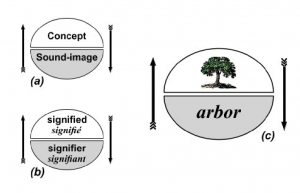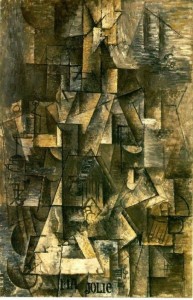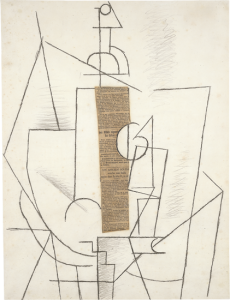Hey bloggers,
Last class we had a brief introduction to language poetry, and we took a quick look at the poem “Susie Asado” by Gertrude Stein. This sparked my interest, as we are currently looking at Pablo Picasso’s work in my Art History class. Picasso’s work is known to have been greatly influenced by Gertrude Stein herself. Both Stein and Picasso have similar stories in their respective fields. Picasso revolutionised the art world with the birth of Cubism, rejecting any kind of rules set by the French Academy at the time. Similarly, Stein rejected the conventional rules of poetry to help create language poetry.
Now to delve quickly into linguistics and Ferdinand de Saussure’s theory of the signifier and the signified. In his theory, Saussu re divides a sign into two parts: the “signifier” and the “signified”. The signifier is the sound or word, while the signified is the actual concept (whether real or not). As you can see on the diagram, the word “tree” is the signifier, and the actual living thing is the signified. The signifier is arbitrary, a sound in the room. If you see an “open” sign in a shop, it is a signifier for the signified concept that the shop is open.
re divides a sign into two parts: the “signifier” and the “signified”. The signifier is the sound or word, while the signified is the actual concept (whether real or not). As you can see on the diagram, the word “tree” is the signifier, and the actual living thing is the signified. The signifier is arbitrary, a sound in the room. If you see an “open” sign in a shop, it is a signifier for the signified concept that the shop is open.
Now back to language poetry, Stein, and Picasso. As we saw in class, language poetry denotes the material aspects of language as opposed to the semantic. It also emphasizes the disjunction and materiality of the signifier, because words are merely sounds after all. We see Stein using these arbitrary words in “Susie Asado” to depict flamenco dancing through the sounds the words make. Picasso goes through a radical change in style in 1907, which is undoubtedly influenced in part by Stein. He starts using seemingly random objects to depict something completely different, just as Stein used random (random as in irrelevant to the actual denotation) words to convey flamenco dancing. They both are representing their meaning abstractly. Stein pays no attention to the actual definition of words, but instead utilizes them to evoke something very different. For example, the words “tray sure” in the poem could mean “treasure” or “très sure” in French (as Stein lived in Paris at the time), and in that way they are completely arbitrary. Some of Picasso’s works include the signifier in the title (Ma Jolie, Bottle and Wineglass) to step away from the representation itself. Without these signifiers, the audience would not have a way of knowing what was being depicted in the painting; just as it would be very difficult to realize Stein is conveying flamenco dancing without knowing Susie Asado was a flamenco dancer.
Before I blog off, I would like to ask: what is the signified without the signifier and visa versa? That will be all for today, and I apologize for getting (literally) abstract.
Blogging off,
Ryan.



One Comment
The sooner you will seek the help of a Sexologist in Delhi the faster you will start seeing the results. Dr. P.K Gupta’s Clinic is well-versed with all sorts of sexual dysfunctions and their meticulous cure that makes him the best sexologist in Delhi.